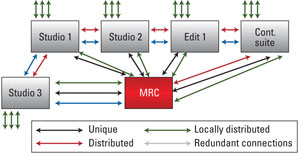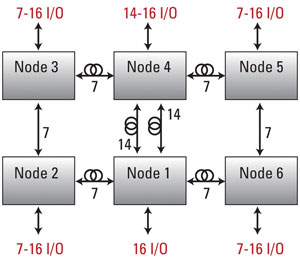Distributed routing networks: Moving past a star infrastructure can increase benefits
Today’s modular routers with optical extensions are fully capable of switching, bringing with them the benefits of the latest technology. There are, however, inherent issues and challenges with traditional star-routing networks with point-to-point passive links. In addition to cost, a change in network configuration, such as the addition of a location in the network, requires significant infrastructure changes and costs, not to mention extreme risk to live video should network downtime result from patching errors.
A distributed routing network based on a compact router construction with an optical extension delivers a more flexible, scalable and fully redundant optical network. Through the addition of a distributed routing layer, it is possible to create a hybrid electrical/optical routing system capable of sending signals long distances while utilizing electrical connections for most of the local distribution. The result is a price competitive and more efficient system.
Past the star
Classic star architecture is not scalable once it reaches the limits of the main router. Additionally, it represents the “brute force” method of distributing signals to all locations. This method was cost efficient when cabling was done through coax cables. With the increased demand for high resolution content requiring high bit-rates, however, the distances coaxial cable could cover decreased, and optical links were required. In a traditional, point-to-point routing system, generally only 20 percent to 30 percent of the primary router is utilized for switching. This leaves 70 percent to 80 percent for distribution and takes the form of an expensive patch panel. An illustration of this is the amount of crew sitting in different locations during a production, watching the main program feed. This feed alone would normally be distributed to five or more places from the central router. And, with the high bit rates of these signals, distribution will be optical. This inefficiency of the router can be utilized when designing a new network.
An intelligent network management application enables broadcasters to take advantage of smaller, compact routers to move from a classic star network with a large primary main router to a distributed, redundant network comprised of smaller, interconnected nodes. Bringing the right management system to the table also enables an efficient workflow. Tie lines bind the distributed routers together, controlled by a management system that automatically finds the most direct and cost-efficient paths through the network. Redundancy is achieved not only from the router but also its configuration.
If a broadcaster wants to add a fourth studio to its current configuration of studios connected to a master control room, it may find that the primary router lacks the number of necessary ports for that expansion. Reconfiguring the main router entails large amounts of re-cabling and numerous patches to avoid network downtime, while limiting the ability to re-use the existing router.
The new approach and resulting configuration is based on identifying the distributed signal (or signals) that must be universally accessed. Consider a live TV setting with its need for different professionals to access the same feed. Let’s say an audio bay, lighting crew and makeup staff are located in different areas. All receive a copy of the same unique, main feed. When distribution is based on a central router, this transport is likely done optically due to distances. In a distributed routing setting, the signal is transported optically from the local distribution router close to the studio, and distributed from there electrically to the three sites. This also frees up cross points and ports to the main router.
A mesh or distributed network continually transmits signals and offers the most significant benefit: the ability to scale. A broadcaster can expand rather than alter its network, adding or replacing a node rather than a router.
This network design also allows distribution of commonly routed signals within the sites, local-to-local connectivity, and improved or maintained redundancy levels. Adding another location to the system does not compromise the network or require complex infrastructure changes. With a hybrid optical fiber network of this type, the broadcaster achieves a redundant system that offers security and scalability at an attractive price.
Redundant networks
Creating a redundant network that cost-effectively maximizes the benefits of optical routing technology and configuration can look something like Figure 1.
In addition to redundancy benefits, a distributed network such as this is easy to scale. Expanding locations is as easy as adding a node. A new level of service capacity is also a welcome byproduct. Capabilities are encased within each node. If you take down or add a node, the system automatically resets to maintain operation and redundancy. Or, you may simply route around a node. Redundancy is achieved through the network, not the router itself. The only potential drawback is the number of components. This potential pain point of numerous components can easily be overcome with a management system that helps automate and run the system.

Figure 1. A broadcast facility configuration can alter the star configuration to keep both unique and locally distributed signals local, as well as commonly routed signals distributed between sites.
An example of a redundant architecture can be seen in Figure 2. Nodes 2, 3, 5 and 6 are made by 32 x 32 routers with 32 optical extensions (16 in/16 out), and nodes 1 and 4 are constructed by 64 x 64 routers with 64 optical extensions (32 in/32 out). Fibers can be broken and nodes can still be reached, as can routers, without dismantling the network. The architecture provides either a 96 x 96 non-blocking or blocking router scheme. Remembering that approximately 70 percent to 80 percent of a traditional star router is used for distribution, this solution may replace a 96 x 96 scheme. Also, it follows that several of the nodes are close enough together for electrical connectivity. This model could be a start to further system optimizations.

Figure 2. This shows a fully redundant 56 x 56 non-blocking network with the capabilities of a 96 x 96 blocking router with distribution. Knowing the classic star router’s limited amount of switching, this is an efficient replacement.
To add studios, sites or nodes, one would connect or alter a limited number of nodes affecting only part of the network. Most upgrade work would have moved from the hardware network to the software control system.
Effective management
A management system that sits on top of this system is critical to providing redundancy and managing system components. The best ones use built-in algorithms to make decisions for the user and hide network operations complexity. For example, an “intelligent” management system will optimize a network’s resources by providing critical path finding. Techniques like shortest-path-first algorithms allow provisioning of the least-costly path from a source to one or more destinations, as well as diverse path routing to support redundancy and provide safest-possible routing. A network must predict all possible moves and the effect a move will have overall. Once a path is allocated, others are blocked.
The best choice is one that has the least-negative (less costly) impact, and intelligence is required to assess effects. Therefore, a cost system is built into the algorithm and enables the system to determine that.
While this is a clear factor in long-haul systems, it’s also significant for in-studio use. Network resources are precious, and efficiencies scale over time. State-of-the-art connection management can also enable dynamic connection on an as-needed basis. This helps achieve key flexibility in today’s pervasive live video setting.
A comprehensive management system should control and manage optical network nodes, while allowing the end user to view the system as a simple, point-to-point configuration that hides complexities of path finding and maintains workflow. All control should be provided by a simple interface that allows easy network configuration, maintenance, troubleshooting and problem resolution.
Getting full value
Distributed routing networks let the broadcaster take advantage of network topology by using low-cost electrical links for distribution, minimizing the number of optical links for >150ft/450ft transport, and creating redundancy for switching on separate routers. This ability readily exists.
Optical routing in a hybrid environment facilitates the ability to stay connected over a large range of ports and remain fully managed across all optical links. This is often not the case with more traditional configurations. Bringing all capabilities into a fully-managed environment enables users to take proactive action and positively impacts the whole value chain. Well-chosen routers, along with smart engineering, can create long-term efficiencies and cost benefits.
—Svein Haavard Haugen is director of engineering, Nevion.
Get the TV Tech Newsletter
The professional video industry's #1 source for news, trends and product and tech information. Sign up below.
